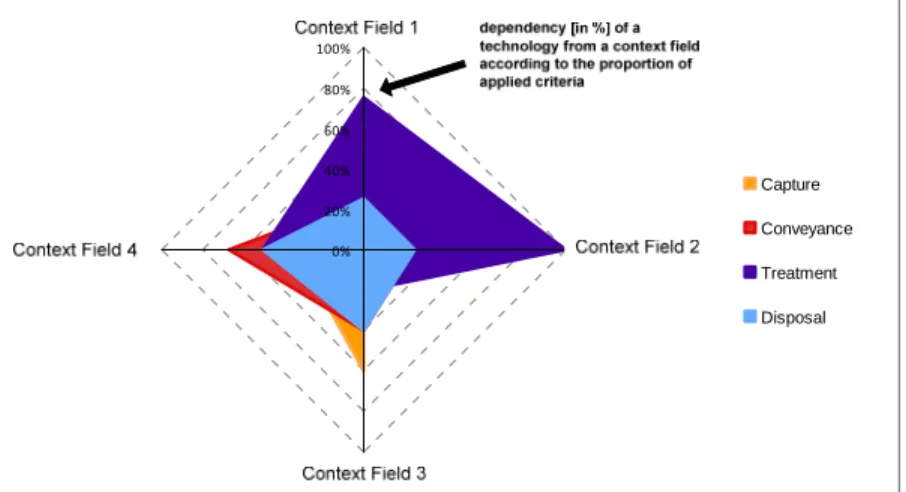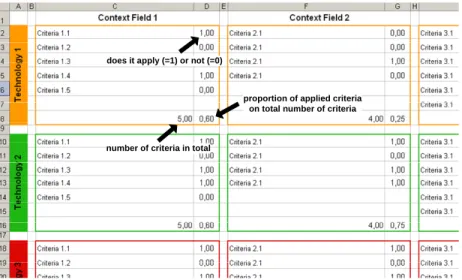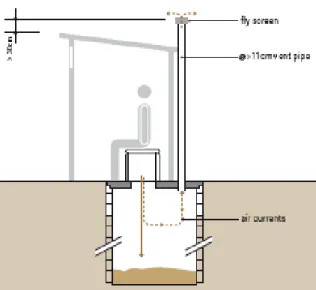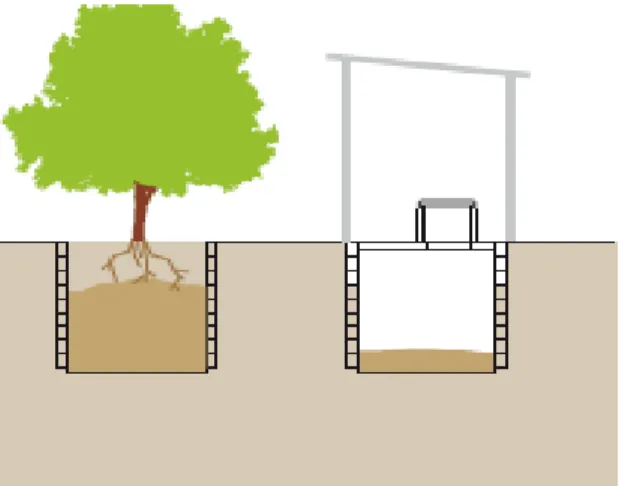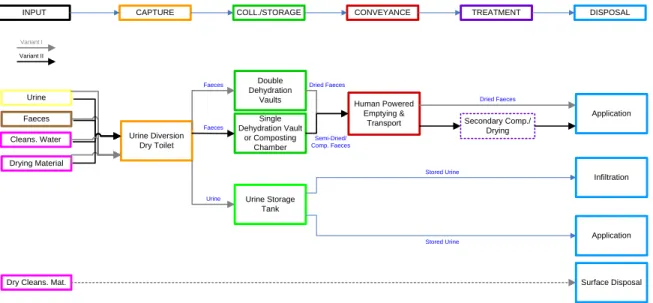7 Evaluation values of component-specific context dependencies of variant I of a pit latrine-based sanitation system. 8 Evaluation values of component-specific context dependencies of variant II of a pit latrine-based sanitation system.
Introduction
Which of these factors can be seen as "limiting" in relation to a technology's use in the context of a developing country. Based on that, existing variations should be proposed with regard to the systems' scope of application.
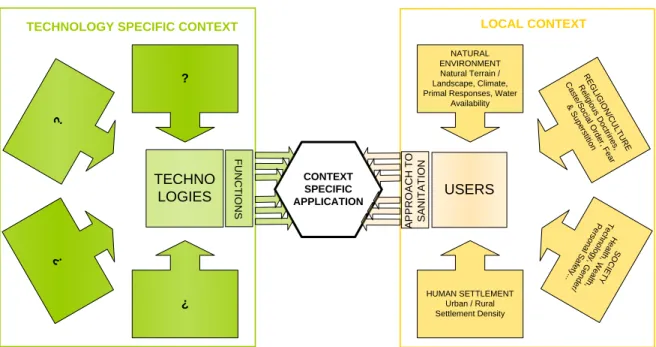
Methodology
- Technology Selection
- System Approach to Sanitation
- Context dependencies
- Consideration Limits
In this way, existing differences in terms of technology and systems contexts and context dependencies should become more visible. In addition, the description undertaken of the technologies involved and their fields of application should only be understood as a summary of their ideal implementation.

Functional Patterns of Selected Sanitation Systems
Overview of the selected Sanitation Systems
Pit-latrine based systems
- Captures: Water-less Toilet and Pour Flush Toilet
- Collection/Storage: Single Pit, Single VIP, Twin Pit, Arborloo Pit
- Conveyance: Human Powered and Motorized Emptying and Transport
- Treatment: Faecal Sludge Treatment Facility
- Disposal: Arborloo concept, Disposal of (treated) Sludge
Thus, further treatment of the faecal sludge that evolves from pits is required (TILLEY et al., 2008 and UNEP, 2010). The application level as well as management responsibilities can be organized similarly to the case of Single Pits (TILLEY et al., 2008).
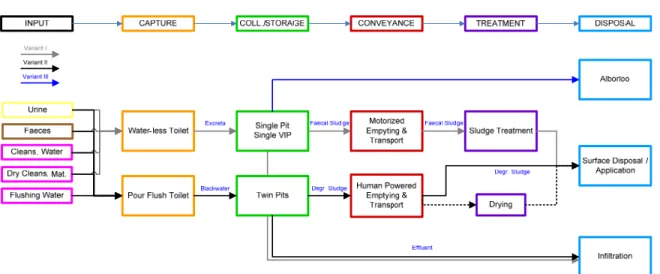
Sanitation Systems focussing on Re-use
- Functional Pattern of a Water-less System with Alternating Pits
- Functional Pattern of Systems for Re-use using Urine Diversion
Generally, however, compost can be directly used (or disposed of) after storage (TILLEY et al., 2008). In addition, the pH may increase, which also has a positive effect on the sanitary process (TILLEY et al., 2008).
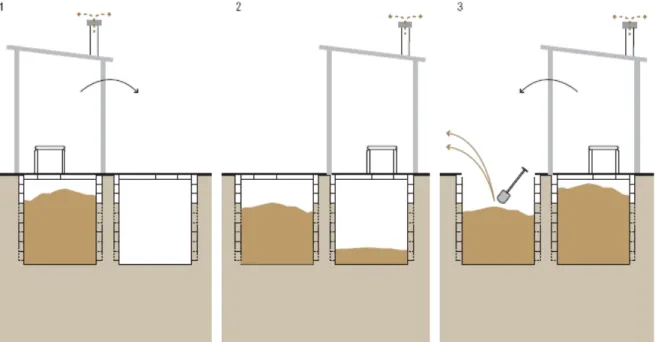
Septic Tank-based System
- Captures: Pour Flush Toilet and Cistern Flush Toilet
- Collection/Storage: Traditional Septic Tank
- Conveyance: Motorized Emptying and Transport of Sludge
- Treatment & Disposal: Effluent Infiltration and Faecal Sludge treatment
The tank, which is located underground, is surrounded by walls and a bottom to prevent liquids from infiltrating the ground. In the design chosen for this work, effluent originating from a septic tank is not transported, but dumped directly on site. Especially in the case of densely populated areas, a transport of the effluent via sewage to a centralized treatment plant is strongly recommended (TILLEY et al., 2008).
In the event that the function of the irrigation pit deteriorates, the material in the facility can be excavated and refilled. Depending on the further processing of the sludge that accumulates in the septic tank, similar steps are used as in single-pit systems.
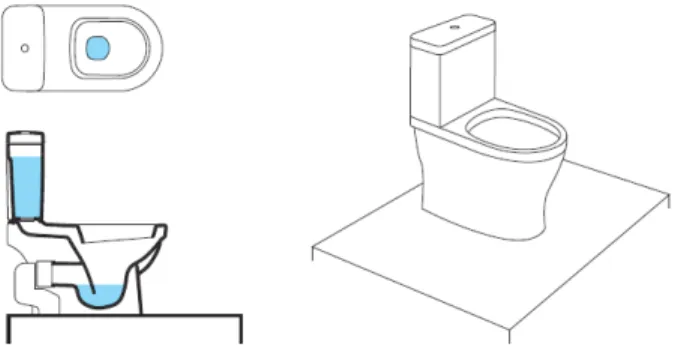
Semi-centralized and Centralized Water-based Systems
- Capture: Cistern Flush Toilet
- Conveyance: Conventional Gravity Sewer, Condominial and Settled Sewer
- Treatment: Intensive and Extensive Wastewater Treatment Facilities
- Disposal: Discharge of Effluent and Disposal of (treated) Sludge
- Re-Use of (treated) effluent and sludge
In case they are laid outside the block, they are usually laid under the pavement on both sides of the road (MARA, 1997 and TILLEY et al., 2008). Condominiums must select an appropriate sewer design to suit local needs and constraints (MELO, 2005). In case of improper storage, there is a risk of accumulation of pollutants in the soil and consequent pollution of the groundwater body (TILLEY et al., 2008).
Furthermore, the organic content of the sludge can be very relevant for increasing the organic content of degraded soils. However, the application rates and purposes of use should not only take into account the presence of residual pathogens and contaminants, but also a sustainable and agronomic amount in terms of the nutrients contained (TILLEY et al., 2008).

Functional Requirements of Sanitation Systems
- Functional Requirements of a Pit-latrine based System
- Captures: Pour Flush and Water-less Toilet
- Collection & Storage: Single Pit/VIP, Twin Pit, Alborloo Pit
- Conveyance: Human Powered and Motorized Emptying and Transport
- Treatment: Faecal Sludge Treatment Facility
- Disposal: Arborloo concept, Disposal of (treated) Sludge
- Functional Requirements for Systems focussing on Re-use
- Functional Requirements of a Water-less System with Alternating Pits
- Requirements Urine-Diverting System focussing on Re-Use
- Functional Requirements of a Septic Tank based System
- Captures: Cistern Flush Toilet and Pour Flush Toilet
- Collection & Storage: Traditional Septic Tank
- Conveyance: Motorized Emptying and Transport of Sludge
- Treatment & Disposal: Effluent Infiltration and Faecal Sludge treatment
- Functional Requirements of Water-based Systems
- Captures: Cistern Flush Toilet
- Conveyance: Conventional Gravity Sewer, Condominial Sewer
- Treatment: Intensive and Extensive Wastewater Treatment Facilities
- Disposal: Discharge of Effluent and Disposal of (treated) Sludge
- Re-Use: Sludge Application on Land
In addition, vehicle access to the treatment centers is necessary to operate and maintain the facility (TILLEY et al., 2008). In terms of maintenance, users should be aware of the suitability of various input materials. Characteristic of the Fossa Alterna-based system is that operation and maintenance can be performed by the users – organized at household or neighborhood level – which implies a sufficient understanding of the whole process (TILLEY et al., 2008).
And on the other hand, with regard to the permeability of the soil, as the wastewater is infiltrated (e.g. by a soaking pit). A public authority must thus take over the responsibility, and society must be able to pay for the high costs in relation to the system's construction, but also operation and maintenance (BUTLER & DAVIES, 2000).

Context Dependencies
Context Fields
Another context field is the settlement pattern, where “density” can be taken as the main indicator. Moreover, the population density is of course related to the capacity aspect – the denser the population, the more capacity an applied system must have and vice versa. An important aspect that can be attributed to this context field is the available water supply structure.
Wastewater production is dependent on the water supply – the better the water supply, the more waste water is generated. Another issue of relevance is the different management and institutional structure needed to install but also run the systems.
Limitations associated to the Context Fields
This factor can be crucial – as some components require significantly more space than others and their feasibility is therefore highly dependent on the availability of space for their installation. Especially in the context of developing countries, the options for supplying materials and goods can be quite limited and so this factor is categorized as distinctive. It is similar to the following two aspects, which can be significant in terms of a community's ability to adequately provide a sanitation system.
In particular, the cost structure for operation and maintenance can be significant as it refers to regularly occurring costs. In the context of developing countries, the requirement of a "high" payment capacity is seen as a critical factor.
Evaluation of Context Dependencies
Component-specific Context dependencies
- Context Dependencies of Pit-latrine based systems
- Context Dependencies of Systems focussing on Re-use
- Context Dependencies of Septic Tank based system
- Context Dependencies of (Semi-/)Centralized Water-based system
Requirements with regard to soil properties and restrictions with regard to the groundwater level determine a dependence on “Natural Environment”. By the way, also in terms of the "Settlement Density" (50% of the applied criteria) some aspects should be considered essential for this part. But especially “Community-specifics” (50% of the applied criteria) appear to be of crucial importance for the function of the components.
For "community specifics" (50% of the criteria used), skilled workers are needed for both construction and O&M (but the skills required for operation may be less sophisticated than for the operation and maintenance of an intensive treatment plant). However, especially “community characteristics” (50% of the criteria used) seem to be crucial in terms of how the components function.
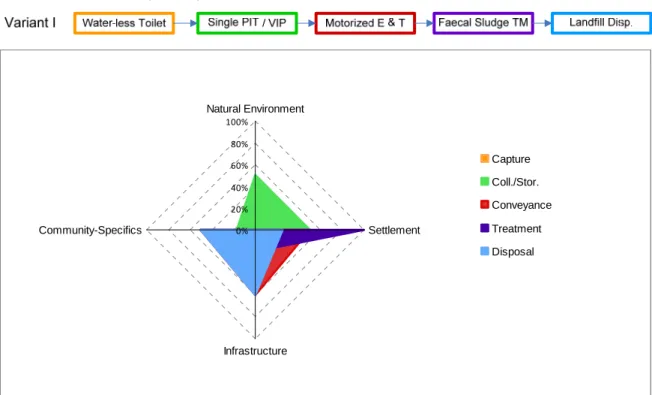
Context dependencies regarding the Systems
Structure of the Settlement: Regarding this contextual field, the highest value can be observed in the case of "System based on a pit", "System based on septic tank" and. While the Conventional Water-based System turns out to be the system with the most obvious dependencies (83%). With a value of 67%, the dependence of the "Alternative Water-Based System" is slightly less, but still a remarkable difference.
Natural environment": This context field appears for all systems of importance (except the . "Recycling-oriented system based on urine diversion"), but the most notable value can be observed in the case of the "Alternative water-based system" (75%). The recycling-oriented system based on urine diversion" (20%) as well as the "Twin Pit-based system" (30%) have comparably smaller levels of dependencies in relation to this context field.
Discussion & Main Findings
As in the case of Arborloo systems, when looking at Fossa Alterna systems, general conditions in terms of "Settlement" and "Natural Environment" are therefore generally the most characteristic. Also interesting is the importance of the Cistern Flushing Toilet in terms of infrastructure requirements. Notable are also dependencies that occur in terms of the Disposal (Discharge of Effluent and Landfill disposal of Sludge) - which are related to requirements regarding all context fields.
Looking at this system as a whole, it is noticeable that the emerging dependencies are important in terms of all context fields. This system has by far the highest dependency in terms of "infrastructure" and "community specifics" of all the systems presented.
Summary
Existing series of dependencies in the course of the sanitation processes were clarified, as well as varying dependency characteristics of the systems presented. Analyzes and comparisons in terms of economics (or also other characteristics) are of course only expressive if they are done for technologies (or technology combinations) of similar functions. The technology-specific context distinctive in terms of function and associated suitability of the systems presented encompassed different domains in and around a community.
Therefore, discussing or even evaluating a technology or system apart from these required contexts is considered insufficient. Therefore, it is assumed that when discussing the potential of specific systems (or approaches) to be established on a large scale, one must be aware that each system operates in specific contexts and that these contexts must be considered in a differentiated manner.
Outlook
UNESC UNITED NATIONS ECONOMIC AND SOCIAL COUNCIL (2004) Sanitation - Policy Options and Possible Actions to Accelerate Implementation. UNDP SSC UNITED NATIONS DEVELOPMENT PROGRAM SPECIAL UNIT FOR SOUTH - SOUTH COOPERATION (n.a) Sulabh Shauchalaya: Low cost sanitation. UNITED NATIONS WORLD WATER ASSESSMENT PROGRAM (2009) World Water Sanitation Development Report 3. 2002) Improving Sanitation and Solid Waste Management in Poor Cities – Module 1: Technical Concepts.
Ecosan – Closing the Loop – Proceedings of the 2nd International Symposium on Ecological Sanitation, which includes the 1st IWA Specialist Group Conference on Sustainable Sanitation. UNITED NATIONS ENVIRONMENT PROGRAM (2010) Environmentally sound technologies in wastewater treatment for the implementation of the UNEP GLOBAL ACTION PROGRAM (GPA) - "Guidance on Municipal Wastewater" - On-site wastewater treatment systems.
Annex
The Concept of “Ecological Sanitation”
Further importance of the project was to establish local capacity for research and development in the field of sanitation, as well as facilitating applied research on sanitation in South-South collaborations (ECOSANRES, 2009). With the emergence and promotion of the idea of “Sustainable Development”, the discussion about misleading developments in the sanitary sector intensified. The announcement of the UN Millennium Development Goals (MDGs), which focused on poverty reduction and sustainable development, reaffirmed the role of a well-functioning sanitation sector and the need for viable and more sustainable solutions.
In the description of the IWA (International Water Association) Specialist Group on Ecological Sanitation, e.g. "ecosan" too equated with "Resource-Oriented-Sanitation". 46 gives an overview of the divided streams, their specific characteristics and examples of their treatment and recycling/disposal.
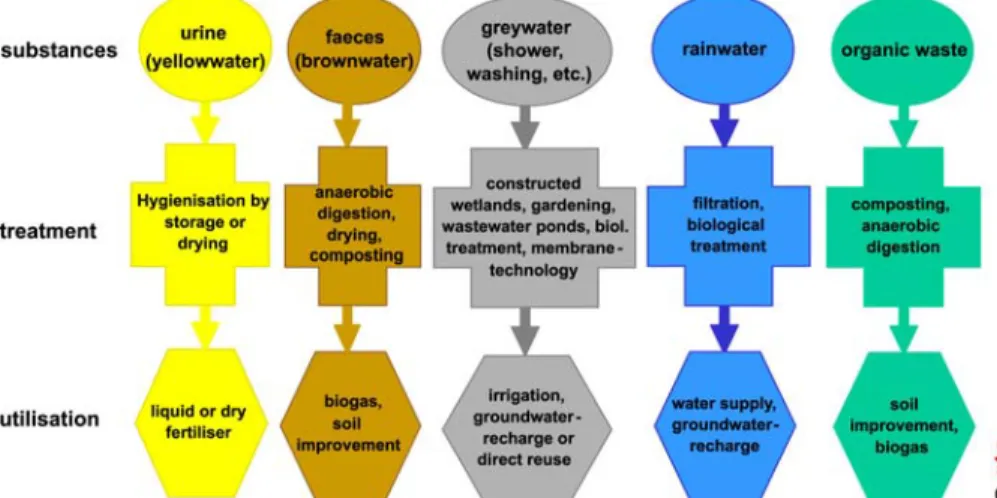
Overview of the most characteristic identified component-specific requirements
Landfill must be available Æ skilled workers, high capital and operating costs. and/or) Combustion site must be available Æ.
Data Input for Evaluations
Transport structures (roads, vehicles, fuel) High solvency for construction/establishment High solvency for O&M. Transport structures (roads, vehicles, fuel) 1.00 High solvency for construction/establishment High solvency for O&M. Transport structures (roads, vehicles, fuel) High solvency for construction/establishment 1.00 High solvency for O&M.
